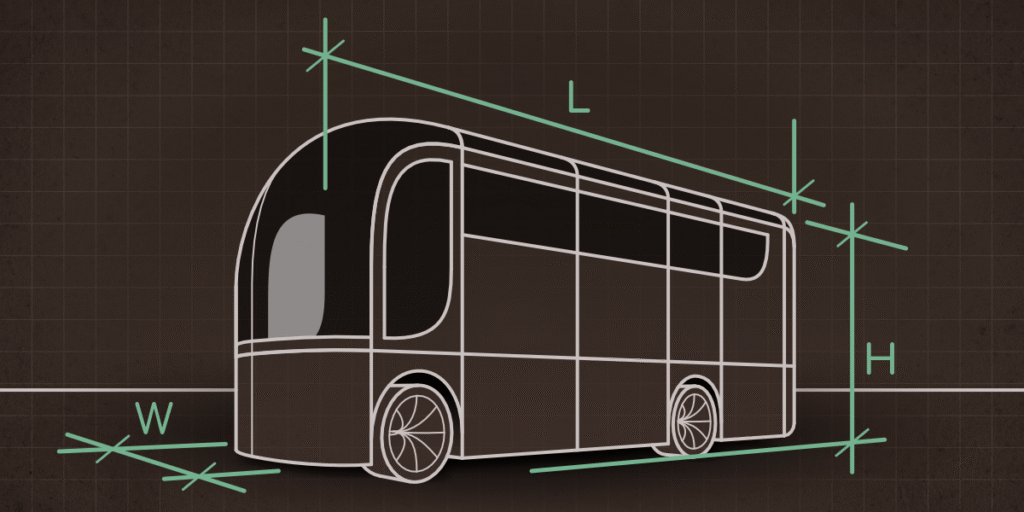Nobody wants to get stuck in a tunnel. Roads, bridges and stations are built with strict limits, and vehicle size regulations decide how high, how wide and how long any vehicle can be. They are the hidden rules that keep traffic safe and the journey possible.

Why Size Matters
Every home on wheels must fit the world it moves through. Roads, bridges and tunnels are built with clear limits, and vehicles that cross them risk safety and legality. A wandering home is no exception, because vehicle size regulations define the boundaries that keep traffic moving safely.
A vehicle that grows beyond its allowed size becomes harder to control and less stable in motion. It may not pass legal registration, it may not fit into parking spaces or service stations, and it may not clear a tunnel or a bridge. Aerodynamics adds another layer. A larger surface catches more wind and demands more energy, while a balanced form can travel farther with less strain.
A vehicle is shaped not only by rules but also by human needs. Safety, comfort, rest, creation and freedom all ask for their place inside the frame. These needs vary from person to person and from one moment of life to another. Modularity offers a way to answer them while respecting the rules of the road but still giving space for life to adapt inside. For a deeper look into how needs guide design, read more in the article Basic human needs.

Global Regulations
Every wandering home must live within the frame of vehicle size regulations. These rules are written to keep roads safe, traffic flowing and infrastructure intact, yet the way they are applied differs across the world.
Europe has worked for decades to harmonise its rules. The goal is simple: a vehicle built in one country should travel freely across the Union without facing conflicting limits. National roads still create exceptions, but the EU pushes toward one common canvas.
The United States follows a different path. Federal law sets the baseline for highways, while each state can add rules for local roads. A motorhome may be legal on the interstates but restricted in a city. There is no federal height limit, so clearances depend on each state.
Elsewhere the picture is just as diverse. Japan sets strict national standards with small exceptions on expressways. China defines safe maximums for both single vehicles and combinations. Australia goes further with the road train, a truck with multiple trailers linked together, stretching across impressive lengths on approved outback routes.
Table below summarizes maximum vehicle dimensions limits across different regions. Values may vary by local regulations (state or provincial). Please check official sources before making design or travel decisions.
Complying with the Rules
The limits are not just recommendations, they are written into law. A vehicle that does not comply with size regulations may be refused registration, stopped on the road or even immobilised until the problem is fixed. Fines are common, and in serious cases drivers can lose license points or face liability if an accident occurs. Insurance may also refuse coverage when a vehicle is outside the legal frame.
Special permits exist for oversized transport such as construction machinery or Australia’s road trains, but they apply only in very specific cases and on approved routes. For a wandering home, the message is simple. Respecting the rules is the only way to keep the journey safe, legal and possible.
The Tipping Point of Size
Bigger vehicles use more material and consume more energy, but they can also carry more. At some point the extra capacity balances or even reduces the footprint per unit of transport. Scandinavia is testing this with High Capacity Transport vehicles up to 34.5 meters long. By running fewer but larger combinations they hope to lower emissions.
For a wandering home, the question is similar. A compact vehicle may be easier to move, but a modular system that grows for specific needs could in some cases be more efficient. The balance between size, energy use and function is not fixed. It must be found carefully, case by case.
The Domovago Canvas
The frame of every design begins with clear dimensions. For Domovago this canvas is set by the limits of the road but also by the search for human comfort and proportion.
The width will be fixed at 2,5 meters (8.2 ft), a balance between maximum legal allowance and practical safety. This gives enough interior space while leaving just enough margin for narrow roads and infrastructure.
The height will rise to 4,0 meters (13.1 ft), the legal maximum in Europe. This choice respects both the Modulor vision of 2,2 meters (7.2 ft) for human space and the golden ratio between width and height. It also creates the room needed for a technical deck below, a living space above, and a roof that can carry insulation and solar panels. The result is a structure that feels generous inside while remaining within the legal frame.
The length will be modular, built in 1,5 meter (4.9 ft) slices that can be stacked together. Within the European limit this allows for up to eight slices, or 12 meters (39.4 ft). In the United States the canvas could stretch to nine slices, or 13,5 meters (44.3 ft). Additional modules could also be placed on a trailer, built from the same 1,5 meter logic.
This modular canvas will act as the foundation of future drawings and experiments, a grid where rules and human needs can begin to take shape.


Key Takeaways
- Rules Define the Frame: Vehicle size regulations set the outer limits every design must respect.
- Needs Shape the Inside: Human comfort, safety and freedom must all fit within those limits.
- The Domovago Canvas: A modular frame of 2,5 m width, 4,0 m height and 1,5 m slices becomes the foundation for future design.
Credits
- Written by: DB
- Images: DB, Freepik